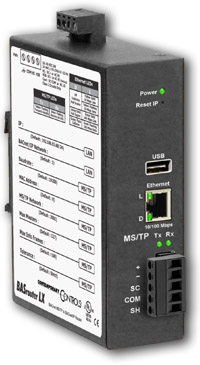Control Network Newsletter

Make Life Easier when Troubleshooting MS/TP Networks
 October 2013 - Troubleshooting a BACnet MS/TP network in the field could be quite a chore. With many devices attached to a single MS/TP twisted-pair wiring bus buried in a false ceiling, you want to be very sure what MS/TP device you need to examine before making the climb to the device. Connecting to a functioning MS/TP network means you need to disturb the communications wiring just to attach your serial protocol tool. A less intrusive approach is to use the built-in diagnostic features in Contemporary Controls' high-performance BACnet® router.
October 2013 - Troubleshooting a BACnet MS/TP network in the field could be quite a chore. With many devices attached to a single MS/TP twisted-pair wiring bus buried in a false ceiling, you want to be very sure what MS/TP device you need to examine before making the climb to the device. Connecting to a functioning MS/TP network means you need to disturb the communications wiring just to attach your serial protocol tool. A less intrusive approach is to use the built-in diagnostic features in Contemporary Controls' high-performance BACnet® router.
In addition to handling BACnet MS/TP to BACnet/IP routing, the BASrouterLX allows you to peek at the MS/TP side of the router from the convenience of a spare Ethernet port on your BACnet/IP network. This could even be done over the Internet. All you need is a copy of Wireshark® loaded on your laptop computer. Wireshark, with a built-in BACnet decoder, can be downloaded for free from the Wireshark website.
Using your web browser, access the web server on the BASrouterLX attached to the misbehaving MS/TP segment. From the Setup tab on the BASrouterLX, jot down the MS/TP MAC address of the router which will help you when examining the Wireshark PCAP captures. In the examples to follow, the BASrouterLX assumed the station address 00. If you want time-stamped events recorded, make sure the time is set correctly on the BASrouterLX. Go to the Status tab and select MS/TP Traffic. There are two buttons - Generate MS/TP Traffic Wireshark File and View MS/TP Traffic. The BASrouterLX is always recording MS/TP traffic using a 3900 line ring buffer. By clicking on the Generate button, the BASrouterLX simply dumps the most recently captured MS/TP data into a Wireshark PCAP file. Once the web browser data transfer ceases, click the View MS/TP Traffic button which opens up the Wireshark program with the transferred file. Scroll through the lines of captured data for points of interest. What follows is a sample of the type of data you may see.
Simple Token Pass
The left-most column of a PCAP file is the frame number followed by date and time stamp. Next is the source address in hexadecimal followed by the destination address. Next are the protocol that is discovered and some information on the type of frame. What is shown is a simple token pass with no stations initiating messages or responding to messages. From here you can learn that station 00 (the BASrouterLX) is passing the token to station 01. Station 01 passes the token to station 02 and cycle continues with the last station 06 passing the token back to the BASrouterLX. What we learn from this is that we have a stable network with a total of seven stations.
Simple Token Pass with a Poll for Master
If address gaps exist between one station and the next higher station, the lower station is required to periodically check if a new station within the gap wants to join the network. This process is called Poll for Master (PFM)). In our example only station 06 has a gap in addresses between it and its logical neighbor being station 00 so it must periodically initiate a PFM. The maximum number of MS/TP masters in a BACnet network is 128 with the highest MAC address at 127 (decimal). If station 06 has been configured for a Max Masters setting of 127, it will test for all addresses between 07 and 7F (hex). Notice that when 06 receives its token it attempts to contact station 16. Since there is no response, station 06 passes the token to 00. On its next opportunity, station 06 will try 17 and will continue this process all the way up to its Max Masters setting. This PFM process is normal and the token passing is not significantly impacted by the occasional PFM.
Directed Message from a BACnet/IP Client
In this example, the BASrouterLX has received a client request from the BACnet/IP side of the network in the form of a ReadProperty of the Present Value of object instance 40 intended for station 01. The BASrouterLX is simply the messenger in this process. Station 01 responds with the data and the the BASrouterLX forwards the information back to the BACnet/IP client. If you want to know the details of the content of the message there is another viewing pane in Wireshark that provides this level of detail. However, one can quickly surmise that the BASrouterLX is properly functioning with its connected MS/TP devices.
The BASrouterLX has several other diagnostic features that will help you commission jobs in the field. For more information, visit the BASrouterLX product page.
|
|